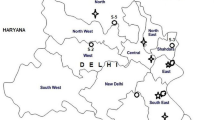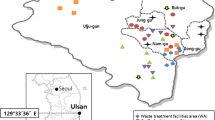Abstract
South Chattanooga has been home to foundries, coke furnaces, chemical, wood preserving, tanning, and textile plants for over 100 years. Most of the industries were in place before any significant development of residential property in the area. During the 1950s and 1960s, however, the government purchased inexpensive property and constructed public housing projects in South Chattanooga. Many neighborhoods that surround the Chattanooga Creek were previous dumping grounds for industry. Polycyclic aromatic hydrocarbons (PAHs) comprised the largest component of the dumping and airborne industrial emissions. To address human exposure to these PAHs, a broad study of South Chattanooga soil contaminant concentrations was conducted on 20 sites across the city. Sixteen priority pollutant PAHs were quantified at two depths (0–10 and 10–20 cm) and compared against reference site soils, as well as to soils from industrially impacted areas in Germany, China, and the USA. From these data, the probability that people would encounter levels exceeding the United States Environmental Protection Agency (USEPA) residential preliminary remediation goals (PRG) was calculated. Results indicate that South Chattanooga soils have relatively high concentrations of total PAHs, specifically benzo[a]pyrene (B[a]P). These high concentrations of B[a]P were somewhat ubiquitous in South Chattanooga. Indeed, there is a high probability (88 %) of encountering soil in South Chattanooga that exceeds the USEPA PRG for B[a]P. However, there is a low probability (15 %) of encountering a site with ∑PAHs exceeding USEPA PRG guidelines.



Similar content being viewed by others
References
ATSDR. (2006). Health consultation: Glover site. Atlanta: Division of Health Assessment and Consultation.
ATSDR (Agency for Toxic Substances and Disease Registry). (1995). Toxicological profile for polycyclic aromatic hydrocarbons (PAHs). U.S. Department of Health and Human Services. (pp. 487).
Bunce, N., Boermans, H., Solomon, K. R., & Ritter, L. (2000). Principles of Toxicology (12th Ed.). Guelph, Ontario: University of Guelph. (pp. 237).
Chun-The, L., Yuan-Chung, L., Wen-Jhy, L., & Perng-Jy, T. (2003). Emission of polycyclic aromatic hydrocarbons and their carcinogenic potencies from cooking sources to the urban atmosphere. Environmental Health Perspectives, 111, 483–487.
DHHS (U.S. Department of Health and Human Services). (2011). The 12th report on carcinogens. National Institutes of Health, National Toxicology Program. (pp. 507).
Doick, K., Burauel, P., Johnes, K., & Semple, K. (2005). Distribution of aged 14C-PCB and 14C-PAH residues in particle-size and humic fractions of an agricultural soil. Environmental Science and Technology, 39, 6575–6583.
Dynamac Corporation. (1991). Field Investigation Report VIII work assignment No. r04019 sampling and analysis of Chattanooga Creek Chattanooga, Hamilton County (pp. 1–60). Chattanooga: TN. ENFORCEMENT CONFIDENTAL.
Fouchecourt, M. O., Arnold, M., Berny, P., Videmann, B., Rether, B., & Riviere, J. L. (1999). Assessment of the bioavailability of PAHs in rats exposed to a polluted soil by natural routes: induction of EROD activity and DNA adducts and PAH burden in both liver and lung. Environmental Research Section A, 80, 330–339.
Górecki, T. (2006). Chromatography. In L. M. L. Nollet (Ed.), Chromatographic analysis of the environment (pp. 133–176). New York: CRC.
HazDat. (2007). Database. Agency for Toxic Substances and Disease Registry (ATSDR), Atlanta, GA.http://www2.atsdr.cdc.gov/gsql/sitecontam.script. Accessed 20 July 2007.
Hensley, A. R., Scott, A., Rosenfeld, P. E., & Clark, J. J. (2007). Attic dust and human blood samples collected near a former wood treatment facility. Environmental Research, 105, 194–199.
International Agency for Research on Cancer. (2006). List of all agents evaluated to date. http://monographs.iarc.fr/ENG/Classification/index.php. Accessed 10 Oct 2006.
Krauss, M., & Wilcke, W. (2003). Polychlorinated naphthalenes in urban soils: analysis, concentrations, and relation to other persistent organic pollutants. Environmental Pollution, 122, 75–89.
Means, J. C., Wood, S. G., Hassett, J. J., & Banwart, W. L. (1980). Sorption of polynuclear aromatic hydrocarbons by sediments and soils. Environmental Science and Technology, 14, 1524–1528.
Menzie, C. A., Potocki, B. B., & Santodonato, J. (1992). Exposure to carcinogenic PAHs in the environment. Environmental Science and Technology, 26, 1278–1284.
Mielke, H., Wang, G., Gonzales, C., Le, B., Quach, V., & Mielke, P. (2001). PAH and metal mixtures in New Orleans soils and sediments. The Science of the Total Environment, 281, 217–227.
Nisbet, I. C., & LaGoy, P. K. (1992). Toxic equivalency factors (TEFs) for polycyclic aromatic hydrocarbons (PAHs). Regulatory Toxicology and Pharmacology, 16, 290–300.
O’Halloran, K. (2006). Toxicological considerations of contaminants in the terrestrial environment for ecological risk assessment. Human and Ecological Risk Assessment, 12, 74–83.
Presley, S. M., Rainwater, T. R., Austin, G. P., Platt, S. G., Zak, J. C., Cobb, G. P., Marsland, E. J., Tian, K., Zhang, B., Anderson, T. A., Cox, S. B., Abel, M. T., Leftwich, B. D., Huddleston, J. R., Jeter, R. M., & Kendall, R. J. (2006). Assessment of pathogens and toxicants in New Orleans, LA following Hurricane Katrina. Environmental Science and Technology, 40, 468–474.
Saltiene, Z., Brukstiene, D., & Ruzgyte, A. (2002). Contamination of soil by polycyclic aromatic hydrocarbons in some urban areas. Polycyclic Aromatic Compounds, 22, 23–35.
Tang, L., Tang, X., Zhu, Y., Zheng, M., & Miao, Q. (2005). Contamination of polycyclic aromatic hydrocarbons (PAHs) in urban soils in Beijing, China. Environment International, 31, 822–828.
Trust for Public Land. (2002). Tennessee Products Superfund Redevelopment Initiative: reuse plans for the Tennessee Products Superfund Site & the Chattanooga Coke State Superfund Site. SRI:1–35.
USEPA. (1993). Provisional guidance for the quantitative risk assessment of polycyclic aromatic hydrocarbons. EPA/600/R-93/089. Washington: Office of Research and Development.
USEPA. (1999). ECOFRAM aquatic and terrestrial final draft reports USEPA. http://www.epa.gov/oppefed1/ecorisk/index.htm. Accessed 1 June 2012.
USEPA. (2007). Tennessee NPL/NPL caliber cleanup site summaries. http://www.epa.gov/region04/waste/npl/npltn/tennprtn.htm. Accessed 15 May 2007. Last updated 30 July 2007.
Weinstein, J. E., Crawford, K. D., Garner, T. R., & Flemming, A. J. (2010). Screening-level ecological and human health risk assessment of polycyclic aromatic hydrocarbons in stormwater detention pond sediments of Coastal South Carolina, USA. Journal of Hazardous Materials, 178, 906–916.
Weston, Inc. (1999). Ecological risk assessment for the Tennessee Products Site Chattanooga, Tennessee. Norcross.
Witt, G., & Siegel, H. (2000). The consequences of the Oder flood in 1997 on the distribution of polycyclic aromatic hydrocarbons (PAHs) in the Oder River Estuary. Marine Pollution Bulletin, 10, 1124–1131.
Witter, B., Winkler, M., & Friese, K. (2003). Depth distribution of chlorinated and polycyclic aromatic hydrocarbons in floodplain soils of the River Elbe. Acta Hydrochmica et Hydrobiologica, 31, 411–422.
Zar, J. H. (1999). Biostatistical Analysis (4th Ed.). New Jersey: Prentice-Hall, Inc.
Acknowledgments
The authors would like to thank Clair Morris, Ben Paulson, and Nellie Shaul from SIUE for their technical assistance with sample collection and analysis. We would also like to thank Andy Carroll from the UTC Office of Academic and Research Computing Services for his help with GIS mapping. We would finally like to thank Troy Keith from the Tennessee Department of Environment and Conservation for all of his logistical support. The study was financially supported primarily by a grant from the National Institutes of Health (1 R15 ESO13129-01). Partial funds were from a Research Grant for Graduate Students awarded by SIUE.
Author information
Authors and Affiliations
Corresponding author
Rights and permissions
About this article
Cite this article
Hussar, E., Richards, S., Lin, ZQ. et al. Human Health Risk Assessment of 16 Priority Polycyclic Aromatic Hydrocarbons in Soils of Chattanooga, Tennessee, USA. Water Air Soil Pollut 223, 5535–5548 (2012). https://doi.org/10.1007/s11270-012-1265-7
Received:
Accepted:
Published:
Issue Date:
DOI: https://doi.org/10.1007/s11270-012-1265-7




